- Bernard Preston homepage
- Broad beans
How to plant broad beans
How to plant broad beans in spring and autumn is the subject of today's column; simply pop the seeds in a row in the ground; sprouting them first between sheets of damp newspaper helps germination. But first put several firmly-placed strong stakes around where each one will go; two to three metres in length.
This is a long page; one of the most important at this site for those who want to live long in the land. Get a cup of tea, sit back and relax, or come back when you have more time; it's not one to skim.
As a DC may I have the temerity to suggest you start any gardening with a simple set of lower back exercises? They take less than two-minutes and will save you perhaps from a lot of pain and expense. I do them myself every morning before arising from bed. At my other site you can find a simple program; they are a lifesaver.
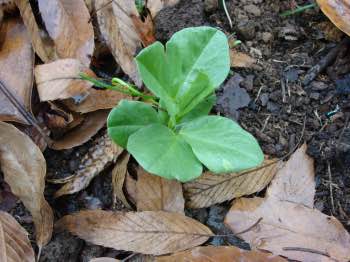
This page was updated by Dr Bernard Preston on 8th January, 2023.
"Not surprisingly, these agricultural techniques require a lot more labor, such as weeding which is why so few farms do it."
- Jim Lyons, New Jersey farmer
I am enamored by all legumes; they fix nitrogen in the soil for their fruit, leaving some behind for the next lot of plants. They provide large amounts of vegetable protein for us and reduce our dependence on red-meat.
Broad beans are particularly rich in many vitamins and beneficial minerals like iron, magnesium and potassium; and they are very easy to grow but must be firmly staked.
Germinating broad bean seeds
Actually germination was less than expected, so now Bernard Preston and company give them a start in cotton-wool; oddly the seed we kept from last year sprouted without a problem. Perhaps those bought packets from the gardening merchant were old stock.
Actually I'm realising there is a huge advantage in keeping your own seed. Natural selection occurs with those plants that adapt to your environment thriving and providing more fruit.
Some of the newer varieties do not germinate well. Straight into the ground not one grew. However, between sheets of wet newspaper, we got shoots within four or five-days.
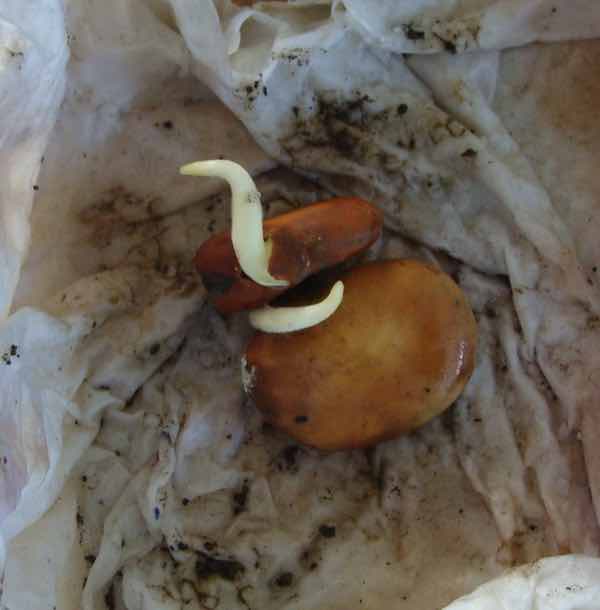
Cholesterol
They are particularly high in phytonutrients called sterols; like
statins they help keep our cholesterol down but in a natural way with no
side-effects.
That means you can have your cholesterol and eat it. They compete with fats in the gut for absorption.
What's more they do not spike your blood-sugar so you can still enjoy them if you are on a low starch meal plan. These broad beans on toast are a great favourite; using artisan bread one need not be anxious about carbs.
If you are not up on legumes, the link[4] at the bottom of this page will give you a lot more information; few subjects are of greater importance for your wellness. I mean that seriously.
Planting
I like the idea behind "no till" but if you are going to get compost into the ground you have to move some soil. Because broad beans need so much water and hate to dry out, I recommend digging quite a large hole and filling it with humus that will keep the roots moist. Add some wood ash to make it alkaline.
Dig these holes in rows about a metre apart; don't crowd your plants. The need air and sunshine.
Offset the holes in the rows to give a little extra space between the plants.
More about staking lower down but I recommend pressing two bamboo canes as deeply into the soil as you can; perhaps 15cm apart.
Drop your germinated broad bean seeds into these holes a metre apart;
they grow into quite large plants, up to two metres high, so space them
every three feet.
The seeds are quite large, so you can easily
plant them an inch or more deep.
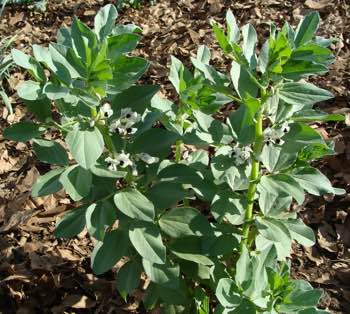
There is little nectar yet in these blossoms, but it will not be long before the bees are busy; they love legumes too. Having an apiary in the garden does not just mean plenty of the best honey; it is also about pollination.
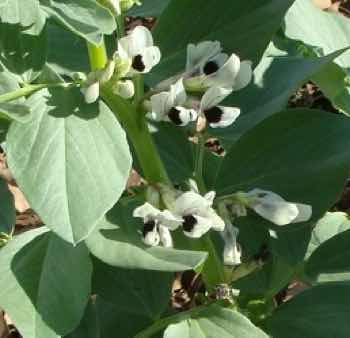
It will not be long now before the first tiny pods start appearing.
As I walk through the garden patch there is now a very pleasant hum as the bees go about their work making sure that every single flower is well-pollinated. We get a mighty harvest every year; 70 pounds per hive.
Satiety
Also known as fava beans they have an important role in the food of many nations all over the world; what is interesting is that they have what is known as a "subsequent meal effect." They keep the blood glucose lower for the rest of the day; you can have your cake and eat it.
Choline is the best source of betaine from your food, a very important enzyme required for the methylation of toxic homocysteine; it's normally a short-lived break down product of protein metabolism but the reaction is absolutely dependent on certain minerals and vitamins.
I have had a particular aversion to broad beans since my youth when I once was forced to eat some that were old and particularly starchy; imagine my surprise when dining with friends we were delighted when they were harvested straight from the garden, cooked imaginatively with herbs and a creamy sauce.
They were absolutely scrumptious. I immediately made plans to find out how to plant broad beans.
Of course a lettuce salad gets a lot of flack these days for the very same reason; fresh vegetables from the garden are without equal.
Staking
How to plant broad beans is not difficult; my biggest problem was standing on them when small in amongst all the autumn leaves being used for mulch. Staking proved to be the solution.
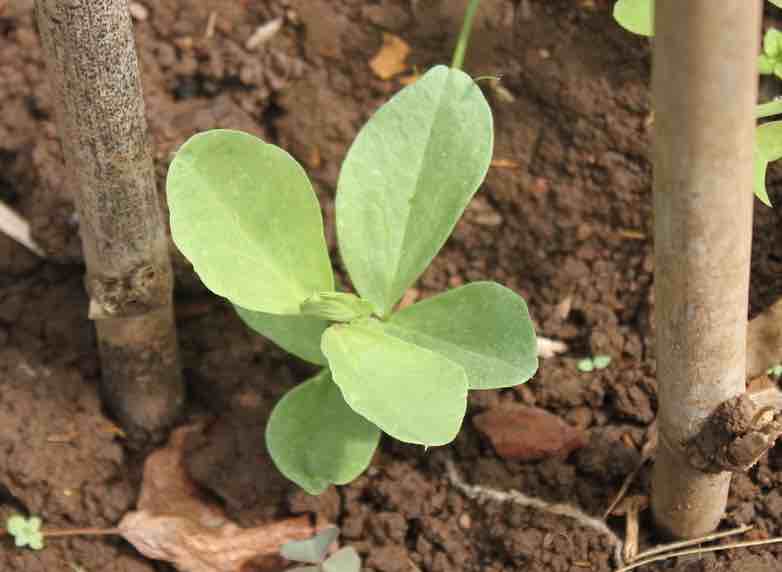
They need a stake or fence; with numerous thick, strong stems that grow to about a metre or more if you mulch them, but the weight of the pods will topple them over in a wind. We now use horizontal frames as well; more about that elsewhere.
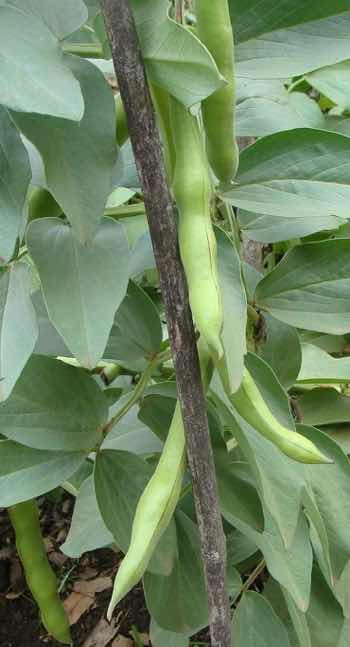
Stakes like these are not really satisfactory unless you have at least one for each stem; the tall upright stems fall between. We are looking at horizontal wooden frames this year.
And yet another decision about supporting our broad beans; with the addition of worm wee, really vermi-leachate, the plants are growing to five feet tall. I now dig a hole at least a foot deep, press two canes as deeply as possible into the ground, and then fill the hole with compost.
A stout bamboo cane, 2.5 m long, firmly planted in the ground is our best solution; plant the germinated seed alongside the stick. Then I will use a thick rap-around string at several levels to support the thick stems. Watch this space.
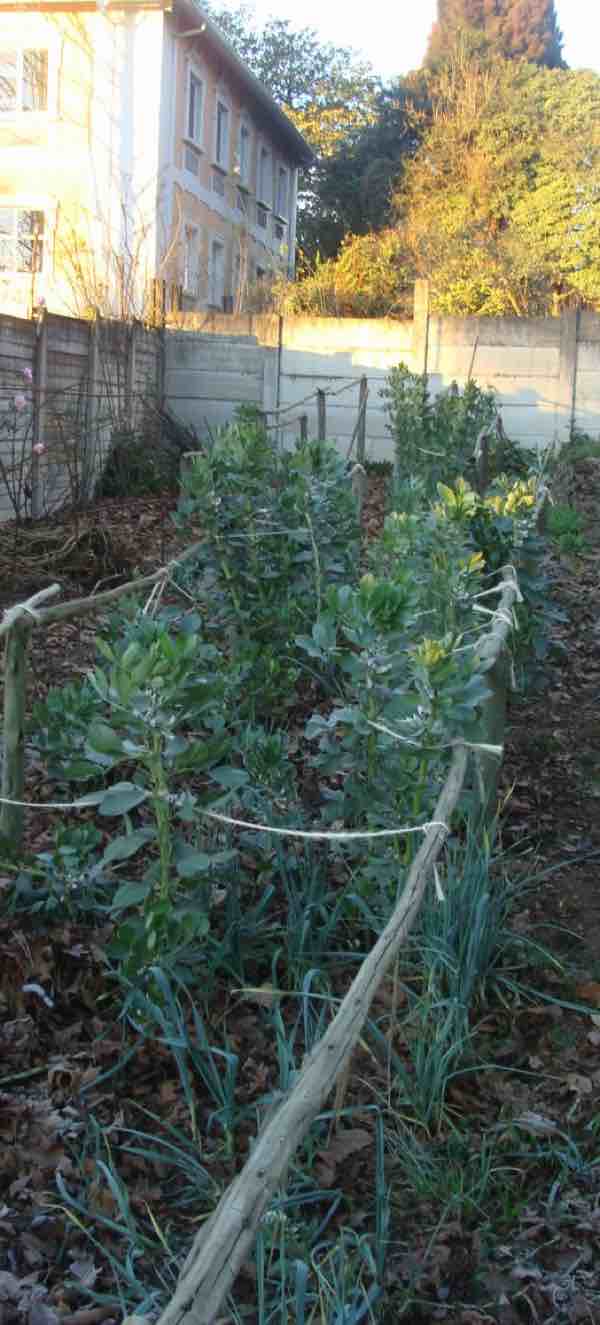
Here they are a year later. In future I will place the supports about 80cm apart so we will not need to tie some of the individual plants. Actually from visiting a friend's garden we have learned to stake each one with a stout bamboo pole; no longer do they fall over and break off at ground level.
Do you not find it amazing that right in town we have such a diverse vegetable and fruit garden? Chickens, bees and worm-farms add other dimensions; and we collect all our water and energy from the skies? You could do it too.
You are probably thinking it would take far too much time and work; well, yes, it does, but the upside is that neither the good wife or I take any medication whatsoever. She has not been near a doctor for over a year, and my last visit was for a skin lesion that I was uncertain about; quite normal solar-keratosis. We also have no need to join a gym or pound out the miles on a soulless treadmill.
So you either spend your time and money on doctors and drugs, or on quality food and a wholesome existence, preserving the planet for the next generation; take your pick.
We focus on stopping nasty diseases like Parkinson's and various malignancies. Much lip service is given to prevention being better than a cure, but there is generally little action; until, too late, when disease arrives. Only other people get them, right?
You may be put off by the fake information that you have to peel the seeds before eating them; absolute nonsense, as far as I am concerned. Just don't let them get old and woody.
Mould on the pods is another issue; some say discard them, but I believe it is a sign they haven't been sprayed with toxic poisons. Just make sure the inner bean is not turning yellow or brown; enjoy them young.
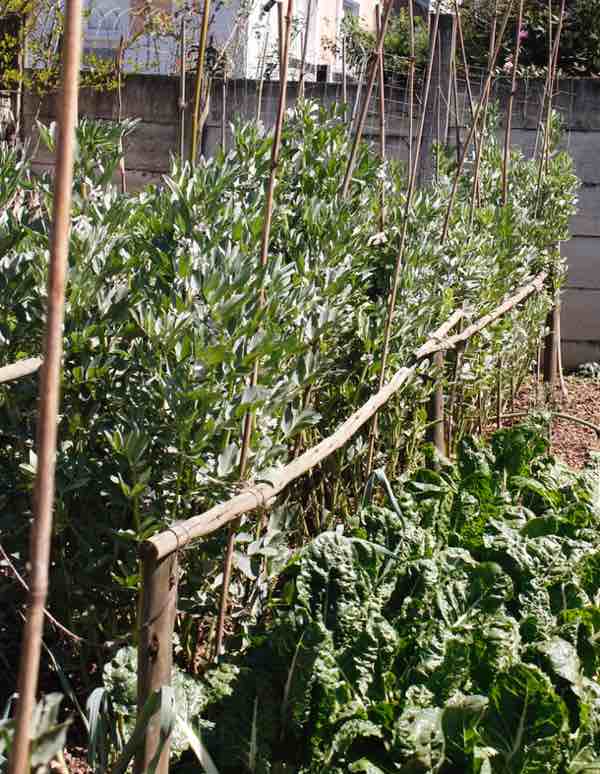
The tallest are now over 6' high; staking and support is essential. They produce a prodigious amount of food. Both they and the Swiss chard are flourishing on leachate.
Tie the plants loosely to the stake; notice the twine is not tightly knotted so it can be easily raised higher as the plant grows, and used again next year.
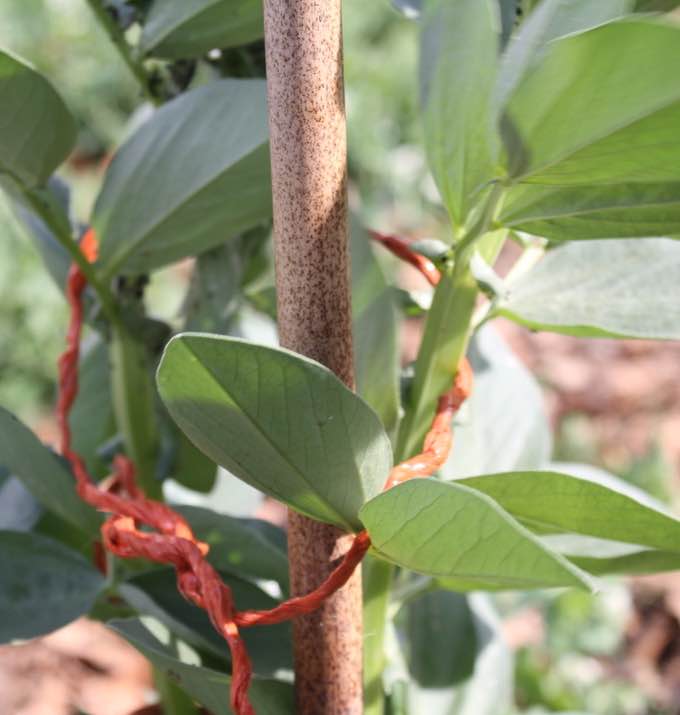
Rhizobia
Inoculating rhizobia onto legume seeds is beneficial.
Unlike many other legumes the fronds do not like high temperatures. In fact, they are much closer to the green-pea than beans. And because they can withstand a moderate amount of cold, you can plant them not only in spring, but also in autumn if you have mild winters.
As nitrogen-fixation bacteria attach to their roots, it is particularly good to
follow crops like corn with broad beans; they help replenish the earth,
and reduce the need for inorganic fertilizer.
Mulching
Fava bean plants need plenty of water; if you don't have a cheap supply available do not bother growing them in the dry season.
You either grow just a few plants close to the house so you can reach them with buckets of water from the shower, or harvest and store the rain.
Mulching certainly helps; then they need much less water.
Compost or mulch the autumn leaves places one firmly on the horns of a dilemma; it was the great need to keep the ground moist when first learning how to plant broad beans that brought us to our senses. Both are important.
Black bean aphids
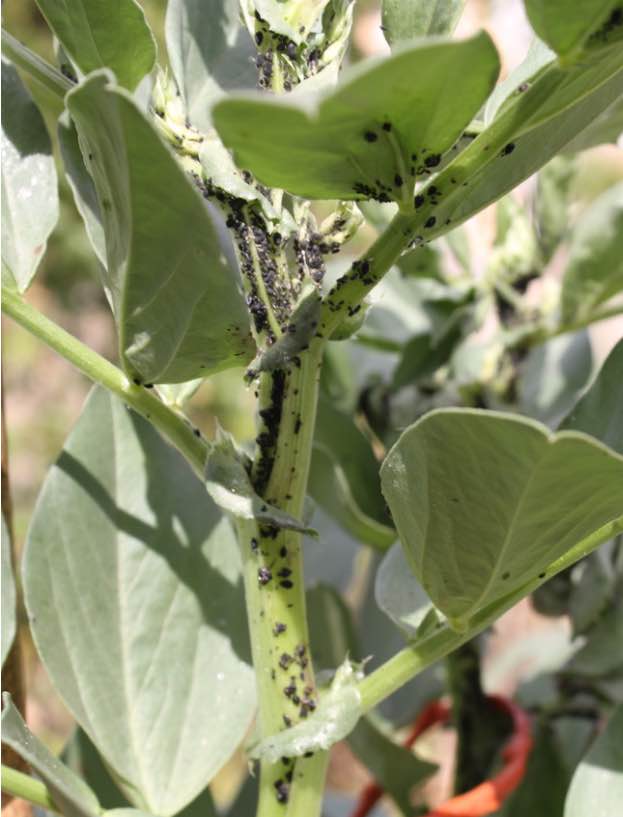
Sap-sucking aphids, sometimes called black fly, are a serious problem in the garden but the good news is that they are easily controlled by spraying with a jet of water, or with white oil. It is a non-toxic mixture of vegetable oil and dish-washing liquid; it asphyxiates rather than poisons the insects.
These black bean aphids appear and get on top of plants that are stressed; in particular in dry spells when they are not getting enough water.
Use your fingers to loosen the aphids whilst spraying or even pouring water from a bottle. In fact this is now my preferred method. Just don't wait so long that they start to stifle the flowers as you can see happening above. It is all part of how to plant broad beans.
I have been using the nectar from our worm farms, known as vermi-leachate[5], and now our plants are growing to two metres; that's why staking is so essential. You can pinch out the tips; it helps control the black fly too..
Black fingernails
16 pods will supply about 140g of beans, yielding 27g of carbs, 7g of fibre and 11g of protein; that's enough for two people.
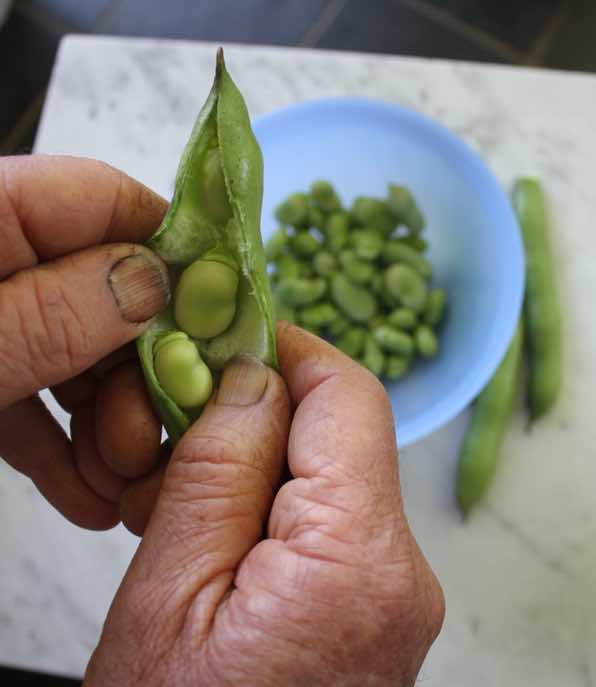
One small problem that took me a while to work out is that the shell of broad beans releases a juice that will stain your hands and in particular give you black fingernails. Scrub as much as you like, but all the world will think you are a dirty gardener who could not be bothered to wash properly; it gets seriously ingrained.
Prevention is better than a cure. When reaping the broad beans that you have planted, instead of breaking the pod off with your thumbnail, give the whole pod a twist.
The pod has what amounts to a zipper down the centre. Slice off the end and pull the skin down to open it. Even use a knife to gently pry it open.
If it bothers you, use gloves when working with the pods.
Some folk recommend peeling your broad beans; a complete waste of time provided you grow them yourself and, after harvesting, bringing the young pods straight to the pot; you lose a lot of time, and invaluable fibre, and much of the L-dopa.
As far as I am concerned, they are not worth eating if someone else has grown them; fresh and young, or not at all, is my motto with broad beans.
Pollen
Researcher Miachasl Flilpiak at Jagiellonian University in Poland has identified that loss of plant diversity has meant that bees are finding it more difficult to discover pollen that will provide all the amino acids that they need for feeding their young and themselves.
Interestingly he recommends broad beans as one of the plants that will provide balanced food for the growing larvae.
Pull or prune?
Many gardening sites recommend pulling out vegetable plants once they are past their best; or should we rather prune them?
I decided about two months ago to prune back all the old stems which had clearly stopped bearing. Lo and behold, about half of them pushed up new shoots, and yesterday I picked 13 pods from one plant. Shorter it is true and with less broad beans in each, but still a bumper crop in what is normally considered the off season.
Most interesting, as we approach the hottest part of the year, I see some self-sown plants coming up; that should not be in mid summer. Watch this space to see how they fare. So they will grow in hotter weather, though less enthusiastically; one can enjoy them for most months.
My mother's favourite poem, never to be forgotten, resonates strongly with me.
"When the world wearies, and society ceases to satisfy, there's always the garden."
Parkinson's disease
There is strong research confirming that once having learned how to plant broad beans, one can assume that you are less likely to get Parkinson's disease; and the condition is better managed when regularly enjoying these high-protein legumes, with markedly less of the very trying dyskinesias.
Researchers conclude in the Journal of Clinical and Diagnostic Research that favas are a good source of natural levo and carbidopa[1], providing a substantial improvement in motor performance, without any of the side effects of the synthetic drug. In short, how to plant broad beans has extremely important implications for us all; it is all about prevention of Parkinson's disease, and a home-based aid to treatment should you have it.
The sprouted form provides twice as much levo and carbidopa on the 8th day. Is it time to learn how to plant broad beans?
The C-dopa in broad beans, also reduces the amount of the levo form needed in the body; that too would mean less medication.
We have never tried sprouting the dry seeds I have harvested; something for the future. Then you can enjoy them throughout the year. Freezing broad beans is another good option.
Researchers have remarked that broad beans have "tremendous applications in the prevention and treatment of highly prevalent Parkinson's disease, tumours and cardiovascular conditions."
Some studies confirm that broad beans can help control the symptoms of Parkinson's disease just as well or better than the medication; half a cup of broad beans contain up to 100mg of levo-dopa. However, in others it does not seem to help at all, and too many may increase the dyskinesia.
In those for whom broad beans work as a substitute for the synthetic drug, it appears that the effect of the legume lasts longer than the medication.
Patients using monoamine oxidase inhibitor medication should discuss the use of broad beans with their doctor first; adverse effects and especially very high blood pressure have been noted.
Broad bean entrepreneurs are needed because those suffering from the disease often do not have the capability to grow the legumes themselves.
The risk factors of Parkinson's Disease describes my journey with the condition.
Dose of broad beans for Parkinson's disease
The recommendation is to start with two tablespoons if you have Parkinson's disease; about five or six beans.
How to plant
broad beans is for you especially. The young pods too are an even richer source than the older, starchy seeds.
You can read more at fava beans nutrition about the use of this legume to manage Parkinson's disease.
Broad bean hummus would make it easier to get the dose right; so many tablespoons each day.
"Start with five mature fava beans, morning and evening; or one young green pod eaten whole."
Carbidopa (C-dopa)
Dopamine in the bloodstream is unable to cross the blood-brain barrier and passes to a group of nuclei called the Striatum; a deficiency of dopamine in this nucleus causes the unpleasant symptoms of Parkinson's disease. It is a very important part of the both the motor and rewards systems.
However, L-dopa (from your broad beans, for example) is able to pass over the barrier into the brain proper.
The breakdown of L-dopa to dopamine is inhibited by C-dopa, enabling the L-dopa to enter the brain where it is processed by another group of nuclei called the Substantia Nigra, before being used in the Striatum.
It is the death of these cells in the Substantia Nigra that limits dopamine production in the brain and causes Parkinson's disease; patients looking for natural solutions are utterly dependent on broad beans and a healthy microbiome.
How to plant broad beans is of great importance to those suffering from the neurodegenerative conditions.
This is all complex stuff, but let it be said that a steady source of both L and C-dopa from the diet helps alleviate the symptoms of Parkinson's disease by supplying a regular supply of dopamine to the brain.
Eat them, and preferably learn how to plant broad beans if you are developing early signs of Parkinson's disease, and perhaps prevent it. In short, let your food be your medicine.
High glycemic index
There is one important downside when you start to enjoy the fruit of your labours from how to plant broad beans. Unlike all the other legumes, they have a fairly high glycemic index if skinned; that means that all the starch will be rapidly digested in the small intestine. However, in the context of our eggs Hilton that we enjoy most days, there is no blood glucose spike.
I am of the opinion but have been unable to confirm this, that mostly they are eaten when older, starchy or dried; and thus have to be skinned, producing the spike. Ours do not give us a blood sugar surge, we think because we enjoy them young and whole.
An analogy could be drawn with a grain of wheat; peel off the bran and you are left with white flour which has a high glycemic index.
Knowing about resistant starch is vital for all of us, if we want to avoid becoming obese but broad beans do not fall into this category unless skinned; they need to be enjoyed in the context of a meal rich in other fibre and some fat. We toss about a dozen whole favas into our Eggs Florentine every morning.
Knowing how to plant broad beans also means more fibre, just a complex carbohydrate that is fermented in the colon for a much happier intestine; new research is finding that this is where the twisted tau proteins that damage the brain are first formed. Enjoy a probiotic daily, we recommend kefir benefits from our food rather than in a pill as is often recommended.
Autumn veggie garden
The autumn veggie garden is a wondrous time; there are still the remains of the summer crop; lettuce, green beans, Swiss chard and jalapenos. The winter squash, also known as butternut, are ripening fast and the scent of a million flowers is being fanned off the honey as the bees ripen the crop.
And it is time to consider how to plant broad beans and a pile of other winter vegetables like broccoli, cabbage and cauliflower.
There certainly is a broad bean season when they are at their best.
Not forgetting the green peas which are probably my favourite legume. Every morning a handful will be thrown in with our Eggs Florentine that we enjoy with our daily breakfast; who says you have to stick rigidly to any recipe?
These are our broad bean tips for growing them successfully.
We now have renamed it Eggs Hilton with our own particular flavours.
Interestingly the heart association has softened up on eggs, and they are now included in the cardiovascular friendly diet; it is probably because they are the richest source of vitamin B12. A deficiency causes a serious disease called pernicious anaemia; it is often fatal, or used to be.
This is particularly true of free range eggs like we enjoy from the chicken tractor. Interestingly there are repeated reports that they have a much lesser effect on blood cholesterol than those raised in cages and barns.
Now the broad bean plants are large we allow the chickens out of the tractor for periods of the day. I will be watching carefully to see if they devastate the fruit as they do with some other legumes. They need the protein for the eggs; but nay they seem to have no interest in them.
How to plant broad beans is easier than you think.
The young pods are growing rapidly; how to grow broad beans has become a regular feature in Bernard Preston's garden; I have numerous patients with Parkinson's disease and I have no desire to join that community!
More about the choline food sources and betaine mentioned above; cut out the inflammation in your body. What is betaine is a subject for everyone who regularly needs NSAIDs or cortisone.
Summer broad beans
The suggestion in the past is that they are a cold weather crop, but this year for the first time we have shown that summer broad beans have been a success. Whilst the production may be down, it is good news for those suffering from Parkinson's disease; it means they can be grown year-round.
Nevertheless broad bean pests have to be considered.
Tabbouleh with broad beans is a great Mediterranean favourite; where many people live to strong and vigorous old age.
Sprouting fava beans
Once you know how to plant broad beans, have grown and reaped them, you can sprout your favas; toss the mature seeds into a jar with water for a day, swilling it periodically. Rinse them and then place them on trays lined with moist paper towels. Cover them with some material impervious to light and let them germinate for a week.
Then you can enjoy the sprouts. The dopamine-precursor content increases as they germinate, maximising on the eighth day, and they cause less flatulence than the dry beans.
However, we have stuck to enjoying the young pods straight from the garden to the pot; high in L-dopa and for me the most enjoyable and simplest way to eat them. Shelling them is time consuming.
This has very important applications for those suffering from and wishing to prevent Parkinson's disease; is how to plant broad beans for you? I think so; it certainly is for me.
Cultivars
There are many cultivars of broad beans with very different nutritional attributes; they are all high in protein but the L-dopa and mineral status varies considerably.
The nutritional profile of broad beans gives some thoughts on the subject.
How to plant broad beans
How to plant broad beans is very relevant because they are extremely high in vegetable protein, the B-vitamins and choline.
What is another name for broad beans?
They are also known as fava, horse and pigeon beans. They are closely related to peas and use the same species of Rhizobia to promote plant growth.
Newsletter
Our newsletter is entitled "create a cyan zone" at your home, preserving both yourself and Mother Earth for future generations; and your family too, of course. We promise not to spam you with daily emails promoting various products. You may get an occasional nudge to buy one of my books.
Here are the back issues.
- Investing in long-term health
- Diseases from plastic exposure
- Intensive lifestyle management for obesity has limited value
- A world largely devoid of Parkinson's Disease
- The impact of friendly bacteria in the tum on the prevention of cancer
- There's a hole in the bucket
- Everyone is talking about weight loss drugs
- Pull the sweet tooth
- If you suffer from heartburn plant a susu
- Refined maize meal and stunting
- Should agriculture and industry get priority for water and electricity?
- Nature is calling
- Mill your own flour
- Bake your own sourdough bread
- Microplastics from our water
- Alternative types of water storage
- Wear your clothes out
- Comfort foods
- Create a bee-friendly environment
- Go to bed slightly hungry
- Keep bees
- Blue zone folk are religious
- Reduce plastic waste
- Family is important
- What can go in compost?
- Grow broad beans for longevity
- Harvest and store sunshine
- Blue zone exercise
- Harvest and store your rainwater
- Create a cyan zone at your home
Second flush
When the shoots die back, cut them off near the ground, but do not pull the plant; in about half of ours they shoot again producing a second flush, not as prolific as the first, but better than a kick in the pants. This is especially true if you mulch them.
Plant protein
On doing some homework, I have discovered that they have four to five times as much plant protein as other fresh peas, beans and legumes in general. There is a strong association between red meat, particularly when processed, and tumours, particularly of the breast. It is no secret that we should be enjoying less beef; how to plant broad beans ought to be on everyone's agenda.
Sigh, this week another wife of a patient at the Bernard Preston clinic goes down with a malignant breast tumour. The first question the oncologist asked, he tells me, was whether she was taking HRT; it doubles the already high risk if you are feasting on large amounts of animal products. In short, all women too should learn how to plant broad beans and other legumes.
It is not only other people who get these serious diseases.
For another viewpoint read about fava beans at Nutrition and You.
Breast tumours and prevention should be on every woman's agenda. Vegetable high in protein is one part of the solution.
Copy and paste "vegetable high in protein" into Site Search in the main menu bar above for more information.
Starch in fava beans
The starch in these fava beans, as they are often called, is not of the resistant type, and occurs in most legumes; it is fairly rapidly digested and absorbed in the small intestine if you peel the seeds.
In the context of the whole meal, that means there should be some fat present; either enjoy them with a smidgen of butter and other protein, or first fry a little onion and then add your beans and a little water. Extra fibre helps slow the absorption of the digested starch molecules, so a helping of kale or other vegetables is beneficial; or enjoy the whole young pods like we do.
Whatever you call them, learn to plant broad beans.
Useful links
When browsing use right click and "Open Link in New Tab" or you may get a bad gateway signal.
"Lower back exercises" are particularly important for gardeners; otherwise you may fall into your DC or worse surgeon's clutches! Prevention is the name of the game. Type it into the Site Search function key in the main menu above.
Seriously though, my own back gets better far more quickly if I have a few treatments from my partner when it starts to play up; but not so many consults that you start to think you may have to mortgage your house to afford the payment. Preparing the soil and learning how to plant broad beans is hard work.
Bernard Preston
Bernard Preston is a semi-retired DC, lover of nature in general and spends a good deal of each day either writing blogs like how to plant broad beans, and his novels.
Have you enjoyed Stones in my Clog, short stories from Bernard Preston's DC coalface whilst doing a stint in the Netherlands?
It's a bargain at $2.99; download it in an instant on your Kindle or smartphone. Wonderful reading for every patient on how to achieve greater well-being naturally. Part of that is by including legumes like broad beans, peas and lentils regularly in your diet.
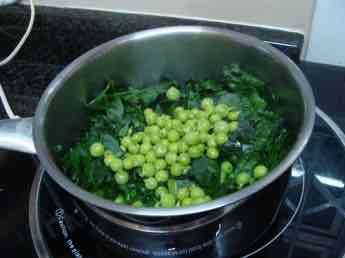
Drop an egg onto this bed of steaming kale and green peas, and then onto a slice of toasted low GI bread and you have the perfect breakfast; I add some onion, and a few slices of red jalapenos too. Some like it hot.
I've been experimenting with broad beans instead of the peas; it is called Eggs Parkinson's disease.
And of course free range eggs have three times the omega-3; that is the stuff that reduces inflammation in the body.
It takes me only five-minutes to mix our low GI bread, by the way. Then of course you have to wait for the machine to do its thing. It's absolutely divine.
- Bernard Preston homepage
- Broad beans
Did you find this page interesting? How about forwarding it to a friend, or book and food junkie? Better still, a social mead tick would help.
- Bernard Preston homepage
- Broad beans
Address:
56 Groenekloof Rd,
Hilton, KZN
South Africa
Website:
https://www.bernard-preston.com